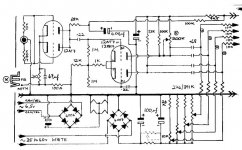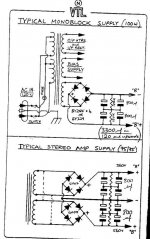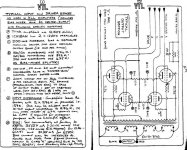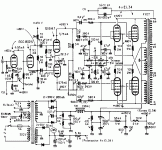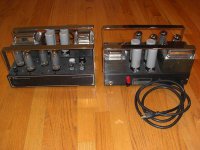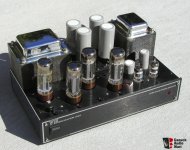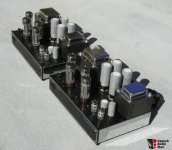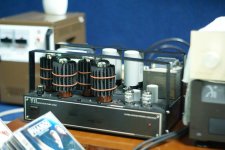A buddy has a pair of VTL Compact 100 Monoblocks (circa 1988) that have performed well, He recently retubed & reset bias with good initial results. Several weeks later one of the pair began blowing mains fuse. I have SS experience but am a newbie at tubes - my first thought given the age was to replace electrolytic capacitors & check tube associated resistors as well as solder joints & socket to tube pin contact. Am I on the right track or are there other obvious items - also if anyone has a schematic that would be very helpful. Thanks!😉
just imagine that amps are SS inside 😉
here are conceptual schematics
go with "non powered " route - if you're not 100% sure what are you doing - start from power xformer primaries , measure everything and compare broken channel amp with good one
then write here
here are conceptual schematics
go with "non powered " route - if you're not 100% sure what are you doing - start from power xformer primaries , measure everything and compare broken channel amp with good one
then write here
Attachments
first of all, you can remove all the EL34 power tubes and check if it blows the fuse. If not, you may check the negative bias voltage to the EL34 are correct. If the -ve bias voltage is correct, you may put a pair of El34 back to the amp....
Have fun.
Johnny
Have fun.
Johnny
Zen Mod & kmtang,
Thanks for the quick replies - will follow your advice & report back (in a few days...I'm on the boat & it's R&R time right now!!)😎
Thanks for the quick replies - will follow your advice & report back (in a few days...I'm on the boat & it's R&R time right now!!)😎
Kevin,
Before digging into the circuit and replacing unneeded parts, I would make absolutely sure the new tubes are not at fault. Regardless of where you got them, if they're new production, they can easily be defective. This is because modern tubes are just not made well anymore.
Since you have two amps, swap the output tubes from one to the other and see if the trouble follows. The EL34 tubes are the most likley to fail. Watch them closely in a dimly lit room for signs of glowing grids or overheated plates.
Only when you are sure the tubes are not at fault, the negative bias voltage on the EL34 grids (pin 5) should be checked. It will be around minus 30 volts. If one is very off, check the adjustment potentiometers and also the .68ufd coupling capacitors for leakage.
Before digging into the circuit and replacing unneeded parts, I would make absolutely sure the new tubes are not at fault. Regardless of where you got them, if they're new production, they can easily be defective. This is because modern tubes are just not made well anymore.
Since you have two amps, swap the output tubes from one to the other and see if the trouble follows. The EL34 tubes are the most likley to fail. Watch them closely in a dimly lit room for signs of glowing grids or overheated plates.
Only when you are sure the tubes are not at fault, the negative bias voltage on the EL34 grids (pin 5) should be checked. It will be around minus 30 volts. If one is very off, check the adjustment potentiometers and also the .68ufd coupling capacitors for leakage.
Hollow State,
Thanks - he did try reinstalling the tubes he replaced & the blowing fuse symptom persisted.
Thanks - he did try reinstalling the tubes he replaced & the blowing fuse symptom persisted.
OK - we spent the morning assessing the fuse blowing amp comparing readings to the good amp. We quickly found the two BY255 diodes on the low side of the B+ supply rectifier shorted. We also measured the resistance from each of the 3 rectifier bridges (B+, bias & filament) downstream & found matching values (within 1%) on the bias and filament supplies between the fuses blowing amp and good amp. The B+ supply value on the fuse blowing amp was about 10% lower than the good amp & when we lifted one side of the 2 shorted diodes the reading agreed within about 2%.
Based on the assessment we ordered replacement BY255 diodes (plan to replace all 4 on the fuse blowing amp & leave the good amp alone). We also ordered replacements for all of the electrolytic capacitors in both amps. We plan to replace diodes & caps on the bad amp & if function is restored then replace caps on the good amp.
Thanks for the advice & particularly to Zen Mod for the schematics...fingers are crossed awaiting parts!😎
Based on the assessment we ordered replacement BY255 diodes (plan to replace all 4 on the fuse blowing amp & leave the good amp alone). We also ordered replacements for all of the electrolytic capacitors in both amps. We plan to replace diodes & caps on the bad amp & if function is restored then replace caps on the good amp.
Thanks for the advice & particularly to Zen Mod for the schematics...fingers are crossed awaiting parts!😎
The parts came in & we spent today installing the replacement BY255s and all of the electrolytics in the problem amp. On power-up it did not blow fuses and all filaments were glowing but a check with signal generator & scope showed output waveform flattened almost to non-existence.
After a few hours of headscratching & comparative readings with the good amp my buddy noticed a resistor in the feedback circuit that apparently got mildly toasted on the diode failure & measured open. We kludged in an array of low power resistors to get the right value and power rating and repowered and the output waveform snapped in right on spec. I'm ordering a proper replacement today and thanks to all for your help and encouragement.😀
After a few hours of headscratching & comparative readings with the good amp my buddy noticed a resistor in the feedback circuit that apparently got mildly toasted on the diode failure & measured open. We kludged in an array of low power resistors to get the right value and power rating and repowered and the output waveform snapped in right on spec. I'm ordering a proper replacement today and thanks to all for your help and encouragement.😀
just imagine that amps are SS inside 😉
here are conceptual schematics
go with "non powered " route - if you're not 100% sure what are you doing - start from power xformer primaries , measure everything and compare broken channel amp with good one
then write here
I am looking for a Service Manual of this model. Thank you for posting the files.
What means the term "typical" ??
Means this term, that the associated circuit was used in exactly the same kind by several other models?
In the attachement several pics - not often to find online.
Attachments
Last edited:
....
What means the term "typical" ??
Means this term, that the associated circuit was used in exactly the same kind by several other models?
...
exactly - as brought in VTL Book
I am looking for a Service Manual of this model. Thank you for posting the files.
What means the term "typical" ??
Means this term, that the associated circuit was used in exactly the same kind by several other models?
In the attachement several pics - not often to find online.
Why not contact Luke Manley @ VTL, Luke is pretty helpful ...
check out my question in post 28 under
https://www.diyaudio.com/community/...out-additional-transistors-or-op-amps.379379/
in post 32 under
https://www.diyaudio.com/community/threads/vtl-deluxe-100-monoblk-kt88-need-help.199153/page-2
there are to find additional files of schematics
https://www.diyaudio.com/community/...out-additional-transistors-or-op-amps.379379/
in post 32 under
https://www.diyaudio.com/community/threads/vtl-deluxe-100-monoblk-kt88-need-help.199153/page-2
there are to find additional files of schematics
Hi, I would like to buy this amplifier, unfortunately it is only one unit. We see two EL34s with white heads, they have lost their vacuum. What could have happened? Can they be overheated? The power plug is 230V Italian, do you know if this model is also compatible with this voltage? Is it worth buying to refurbish it and what would be a fair price to buy it?
some photos



some photos
tubes are loosing vacuum in that catastrophic way - white inside, in 99.9% of cases - due to mechanical force
left one is even torn from Bakelite base, I can bet that right one is loose too
in short - something wacked that tubes , glass got crack in bottom side
rest of questions - it must be inspected first, to deduce what's exact situation with mains voltages
left one is even torn from Bakelite base, I can bet that right one is loose too
in short - something wacked that tubes , glass got crack in bottom side
rest of questions - it must be inspected first, to deduce what's exact situation with mains voltages
Unfortunately I don't have the opportunity to inspect it before buying it. Can you advise me on a purchase price?
No
But I can advise you one thing: if you need to ask these sort of questions, considering that's just one channel and considering sort of circuitry inside ( high voltages, so better not amateur fingerpoking) ..... just pass it
Tube amps in general, and especially those of higher power - if you don't have substantial mileage in electronics - in best scenario it'll end as long and expensive fiasco; in worst scenario - much worse
But I can advise you one thing: if you need to ask these sort of questions, considering that's just one channel and considering sort of circuitry inside ( high voltages, so better not amateur fingerpoking) ..... just pass it
Tube amps in general, and especially those of higher power - if you don't have substantial mileage in electronics - in best scenario it'll end as long and expensive fiasco; in worst scenario - much worse
Ok, thanks for the advice. I've made an amp with PCL82s in the past. The seller asks 350 euros for the VTL + gives away a quartet of EL34 TADs. I wanted to know if it's worth it, the price seemed high to me, I wanted to offer 250 euros. But maybe it's better to pass.
even if neglected, stereo pair is worth more than 700E
but really - what's worth just one?
it's only logical to think of using it as guitar amp, but then - it's just power amp - thinking of tube amp , much better package is to have proper guitar amp
but really - what's worth just one?
it's only logical to think of using it as guitar amp, but then - it's just power amp - thinking of tube amp , much better package is to have proper guitar amp
I enjoy restoring vintage electronic devices and refurbishing them. Like tube radios etc. I would have gotten it in the hope of finding another one to pair it with in the future! But I think it is very difficult for this to happen!
HiUnfortunately I don't have the opportunity to inspect it before buying it. Can you advise me on a purchase price?
send a private msg to me
The circuit is not complicated
But some check are necessary
Walter
- Home
- Amplifiers
- Tubes / Valves
- VTL Compact100 Monoblock Blows Fuse
